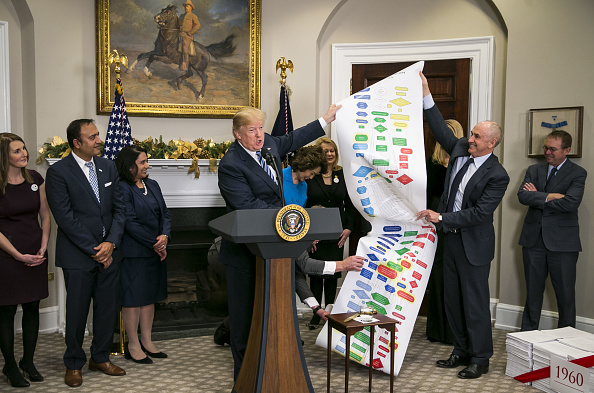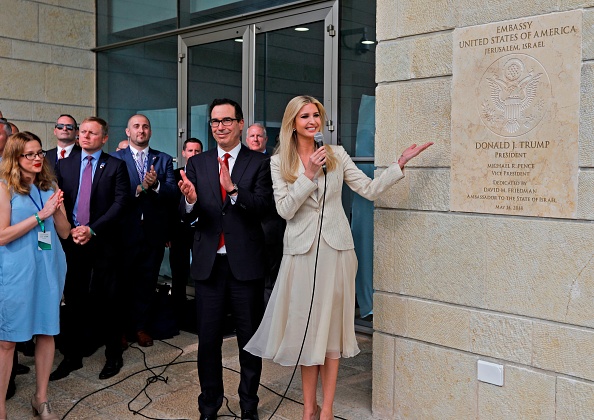When Donald Trump was asked about the effects of a vote by Great Britain to leave the European Union, he speculated that a weaker British pound could boost sales at his golf course in Scotland.
When he made his first speech before the United Nations General Assembly, he noted that the building he was speaking in had helped make a nearby residential tower of his a success. And when he was addressing racial violence in Charlottesville, he took time to note that he owns a nearby winery.
In short, Trump may be the commander-in-chief, but he still thinks like a developer.
During his time on the campaign trail and in his first year in office, Trump has shown that he still approaches some of the most intractable problems in U.S. politics — immigration, the economy and the Middle East — as a series of concrete building projects, looking to pull together a deal, find financing and sell the finished product to the public.
During the campaign this approach helped. It led him to emphasize concrete ideas, like a border wall, new roads and airports and an embassy in Jerusalem, that voters could easily grasp and which he painted himself as uniquely qualified to deliver.
But in office, he’s struggled with the same issues that sometimes plagued his real-estate projects as a developer: finding financing, getting bureaucratic approval and dealing with public disappointment when the project is scaled back.
Trump, who argued that his experience renovating the Wollman Ice-Skating Rink in Central Park was a qualification for the presidency, even doing a televised interview from the side of the rink, has found these projects much tougher to pull off.
Here’s an overview.
‘Build the Wall’

In the past, immigration hardliners typically called for tighter limits on visas to enter the U.S., mandatory employment-verification programs and stronger border security. But as a candidate Trump made a wall on the border with Mexico the centerpiece of his approach.
In interviews and at campaign rallies, Trump would wax on about the wall the way a builder might describe a new hotel.
“I will build a great wall — and nobody builds walls better than me, believe me — and I’ll build them very inexpensively,” he said at his campaign launch in June of 2015. He said it would be made of precast concrete, going into detail about how it would be constructed and how it would stretch a thousand miles along the border at a height of anywhere from 30 to 65 feet.
He also said the wall might come with solar panels, see-through areas for transparency, or even windows.
At times, Trump almost sounded like he was describing one of his Trump Organization projects.
“I want it to be so beautiful because maybe someday they’ll call it the Trump Wall. Maybe. So I have to make sure it’s beautiful, right?” he said at a campaign event in 2015. “I’ll be very proud of that wall.”
As president, Trump has continued to push for a wall, even checking out prototypes in California like a developer visiting a construction site. But he’s struggled to get Congress to approve funding. Without a clear plan, the Trump Wall may end up like so many unrealized real estate dreams, just a shadow of its big promises.
Infrastructure Week

On the campaign trail, Trump also promised to revitalize American infrastructure, arguing that the country “needs new roads, new tunnels, new bridges, new airports, new schools.”
During a debate, Trump argued that flying into U.S. airports like LaGuardia in New York City was like visiting a “third-world country” compared to their brand new counterparts in China.
It was a line he’d repeat during a speech at Trump Tower touting his infrastructure initiatives in August of 2017, remarks that were largely overlooked after he went off-script to argue that there was “blame on both sides” for violence that erupted at a white supremacist rally in Charlottesville, Va.
In fact, it’s become something of a running joke in Beltway circles that Trump’s periodic “infrastructure weeks” end up focusing on almost everything but the nation’s roads and airports.
But the big problem for Trump’s infrastructure plan isn’t inattention. It’s the same one that regularly bedevils real-estate projects: getting funding. Though Trump once talked of a plan that would spur more than $1 trillion in public and private investment, the Administration has struggled to come up with a way to pay for it, and a massive tax overhaul he signed in December made it even harder to find money in the federal budget.
Jerusalem Embassy

In 1995, President Bill Clinton signed a law mandating that the U.S. embassy eventually be moved to Jerusalem, but he and successors George W. Bush and Barack Obama ended up delaying the move out of concern it would destabilize the region.
During the campaign, Trump pledged to move the embassy once and for all and formally recognize Jerusalem as Israel’s capital, and his announcements focused on the very concrete act of building a new embassy.
“This will immediately begin the process of hiring architects, engineers, and planners, so that a new embassy, when completed, will be a magnificent tribute to peace,” he said.
The opening of the new embassy, attended by Treasury Secretary Steve Mnuchin, daughter Ivanka Trump and son-in-law Jared Kushner, had all the pomp and ceremony of a ribbon-cutting at a new real estate development, with Ivanka even pulling down a blue curtain to unveil a plaque with Trump’s name on it.
But like many real estate projects where Trump has licensed his name, the new embassy is less than it appears, consisting of a new plaque and around $400,000 of modifications and additional security to a former consular services building.
Still, unlike the wall or the new roads and airports, it is there, and for Trump, especially, that means a lot.
More Must-Reads from TIME
- Donald Trump Is TIME's 2024 Person of the Year
- Why We Chose Trump as Person of the Year
- Is Intermittent Fasting Good or Bad for You?
- The 100 Must-Read Books of 2024
- The 20 Best Christmas TV Episodes
- Column: If Optimism Feels Ridiculous Now, Try Hope
- The Future of Climate Action Is Trade Policy
- Merle Bombardieri Is Helping People Make the Baby Decision
Contact us at letters@time.com